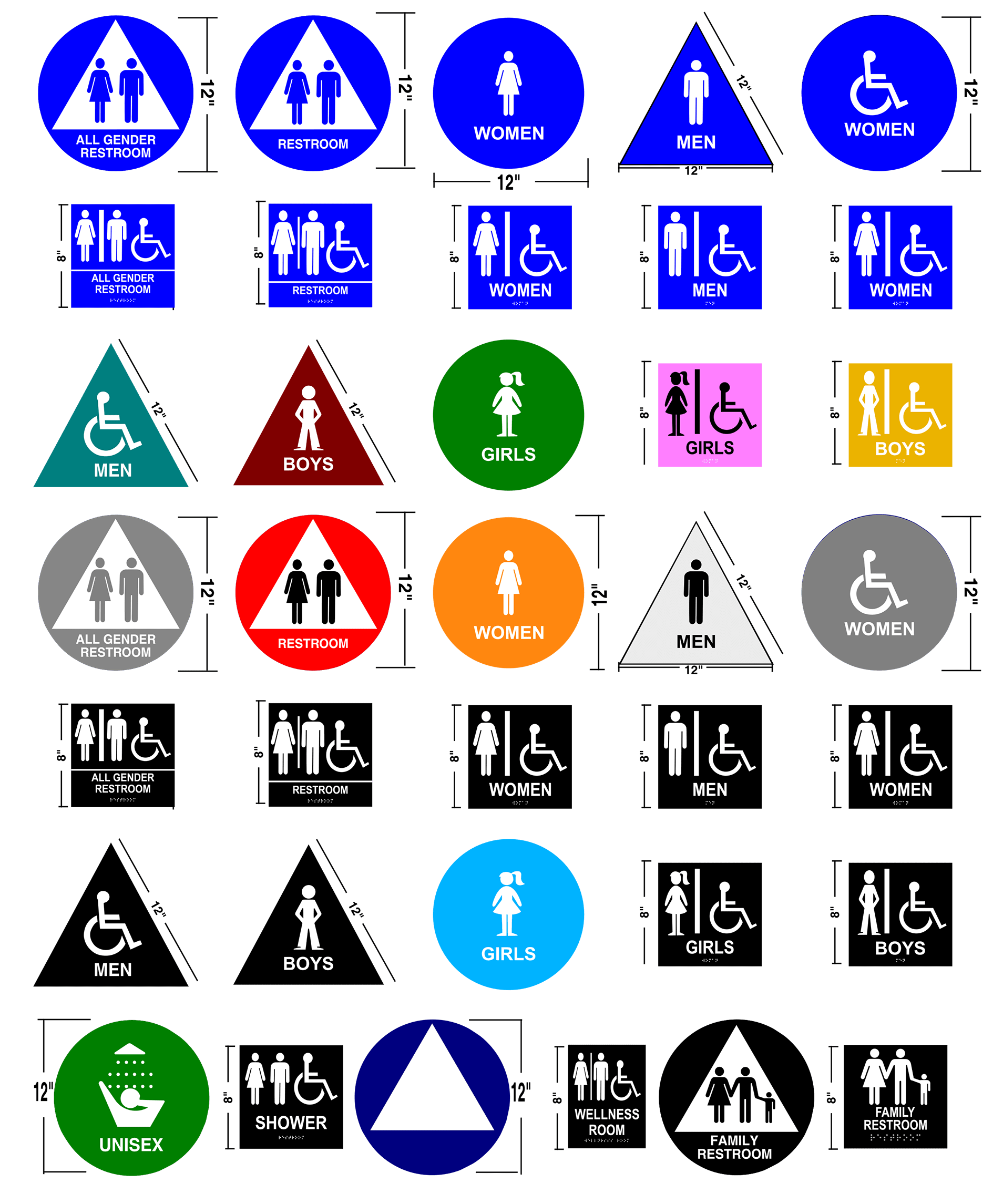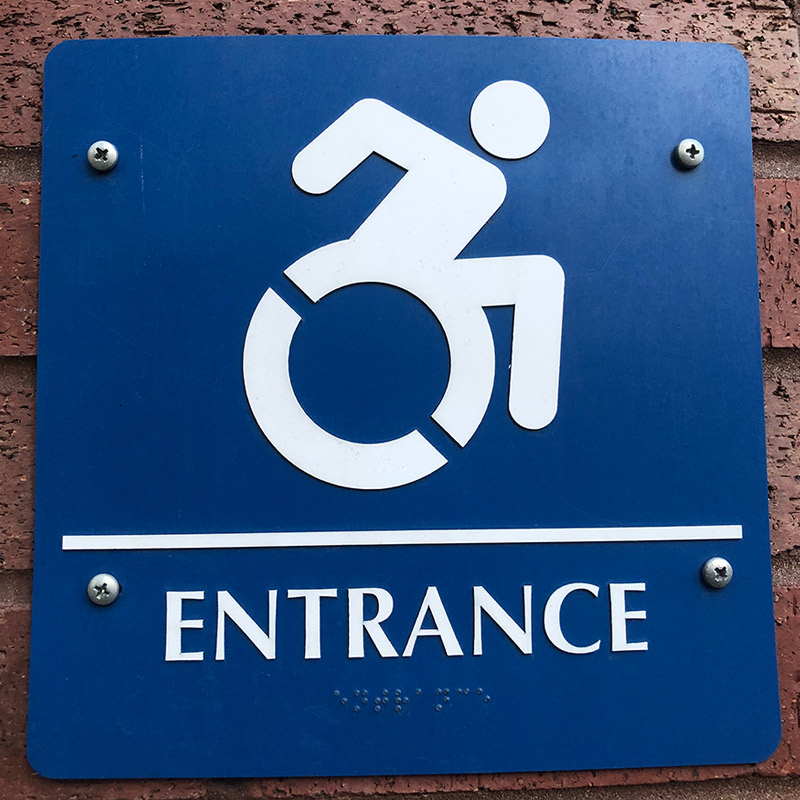Exploring the Trick Functions of ADA Indicators for Improved Access
In the world of ease of access, ADA signs serve as quiet yet effective allies, ensuring that areas are navigable and comprehensive for individuals with impairments. By incorporating Braille and tactile aspects, these indications damage barriers for the aesthetically damaged, while high-contrast color plans and readable fonts provide to diverse visual demands.
Significance of ADA Compliance
Making certain conformity with the Americans with Disabilities Act (ADA) is essential for fostering inclusivity and equal access in public areas and workplaces. The ADA, passed in 1990, mandates that all public centers, companies, and transportation solutions accommodate individuals with disabilities, guaranteeing they appreciate the very same rights and opportunities as others. Compliance with ADA criteria not just satisfies lawful responsibilities however additionally boosts an organization's credibility by showing its dedication to diversity and inclusivity.
One of the key aspects of ADA compliance is the application of obtainable signs. ADA indications are developed to guarantee that people with disabilities can easily browse through rooms and structures.
In addition, adhering to ADA regulations can minimize the danger of legal consequences and possible penalties. Organizations that fall short to follow ADA guidelines might encounter suits or charges, which can be both damaging and financially burdensome to their public picture. Thus, ADA conformity is integral to promoting a fair setting for everyone.
Braille and Tactile Components
The consolidation of Braille and tactile elements into ADA signage personifies the concepts of access and inclusivity. These functions are crucial for people who are visually damaged or blind, allowing them to browse public areas with better independence and self-confidence. Braille, a tactile writing system, is important in supplying created details in a style that can be conveniently regarded via touch. It is usually put beneath the corresponding text on signage to make certain that people can access the details without aesthetic assistance.
Tactile components expand beyond Braille and include increased icons and characters. These components are designed to be discernible by touch, allowing people to recognize space numbers, toilets, leaves, and various other important locations. The ADA sets details guidelines relating to the size, spacing, and positioning of these tactile elements to maximize readability and make certain consistency throughout different atmospheres.

High-Contrast Color Design
High-contrast color design play a pivotal function in boosting the presence and readability of ADA signs for people with visual impairments. These systems are crucial as they maximize the difference in light reflectance in between message and history, ensuring that indications are easily noticeable, even from a range. The Americans with Disabilities Act (ADA) mandates using particular color contrasts to suit those with restricted vision, making it an important facet of conformity.
The efficacy of high-contrast colors depends on their capability to stand out in various lights conditions, including dimly lit settings and areas with glow. Usually, dark text on a light background or light message on a dark background is utilized to achieve optimal comparison. Black text on a see yellow or white history offers a raw aesthetic distinction that assists in quick acknowledgment and understanding.

Legible Fonts and Text Size
When taking into consideration the design of ADA signage, the selection of understandable typefaces and appropriate message dimension can not be overstated. These aspects are important for ensuring that signs come to people with visual impairments. The Americans with Disabilities Act (ADA) mandates that font styles have to be not italic and sans-serif, oblique, manuscript, highly attractive, or of uncommon form. These needs help guarantee that the message is easily understandable from a distance and that the characters are appreciable to varied target markets.
According to ADA guidelines, the minimum message height need to be 5/8 inch, and it should increase proportionally with watching distance. Consistency in message dimension contributes to a natural visual experience, aiding people in browsing settings efficiently.
In addition, spacing in between letters and lines is essential to clarity. Sufficient spacing avoids personalities from appearing crowded, boosting readability. By sticking to these requirements, developers can substantially enhance access, making certain that signs serves its desired function for all people, no matter of their visual capacities.
Efficient Placement Approaches
Strategic positioning of ADA signage is crucial for optimizing accessibility and making sure compliance with lawful standards. Effectively positioned indicators direct individuals with disabilities efficiently, assisting in navigating in public rooms. Trick factors to consider consist of height, distance, and visibility. ADA standards state that indicators should be placed at a height in between 48 to 60 inches from the ground to guarantee they are within the line of view for both standing and seated people. This conventional elevation variety is essential for inclusivity, making it possible for wheelchair users and individuals of varying elevations to accessibility details effortlessly.
Additionally, signs should be placed nearby to the lock side of doors to permit easy recognition before access. Consistency in sign placement throughout a facility enhances predictability, lowering complication and enhancing total customer experience.

Conclusion
ADA indicators play a crucial duty in promoting ease of access by integrating functions that attend to the demands of individuals with disabilities. These elements collectively cultivate a comprehensive atmosphere, underscoring the significance of ADA conformity in making certain equivalent gain access to official site for all.
In the realm of availability, ADA indicators serve as quiet yet effective allies, guaranteeing that spaces are comprehensive and navigable for people with impairments. The ADA, passed in 1990, mandates that all public facilities, companies, and transport services click for source suit individuals with impairments, ensuring they enjoy the very same rights and opportunities as others. ADA Signs. ADA indications are created to make sure that people with disabilities can conveniently browse via structures and areas. ADA standards specify that signs should be mounted at an elevation between 48 to 60 inches from the ground to ensure they are within the line of view for both standing and seated individuals.ADA indications play an important function in promoting availability by incorporating functions that attend to the needs of individuals with specials needs